Navigating Deep Space By Starlight

Navigating Deep Space by Starlight
On August 6, 1967, astrophysicist Jocelyn Bell Burnell noticed a blip in her radio telescope data. And then another. Eventually, Bell Burnell figured out that these blips, or pulses, were not from people or machines.

The blips were constant. There was something in space that was pulsing in a regular pattern, and Bell Burnell figured out that it was a pulsar: a rapidly spinning neutron star emitting beams of light. Neutron stars are superdense objects created when a massive star dies. Not only are they dense, but neutron stars can also spin really fast! Every star we observe spins, and due to a property called angular momentum, as a collapsing star gets smaller and denser, it spins faster. It’s like how ice skaters spin faster as they bring their arms closer to their bodies and make the space that they take up smaller.

The pulses of light coming from these whirling stars are like the beacons spinning at the tops of lighthouses that help sailors safely approach the shore. As the pulsar spins, beams of radio waves (and other types of light) are swept out into the universe with each turn. The light appears and disappears from our view each time the star rotates.

After decades of studying pulsars, astronomers wondered—could they serve as cosmic beacons to help future space explorers navigate the universe? To see if it could work, scientists needed to do some testing!
First, it was important to gather more data. NASA’s NICER, or Neutron star Interior Composition Explorer, is a telescope that was installed aboard the International Space Station in 2017. Its goal is to find out things about neutron stars like their sizes and densities, using an array of 56 special X-ray concentrators and sensitive detectors to capture and measure pulsars’ light.

But how can we use these X-ray pulses as navigational tools? Enter SEXTANT, or Station Explorer for X-ray Timing and Navigation Technology. If NICER was your phone, SEXTANT would be like an app on it.
During the first few years of NICER’s observations, SEXTANT created an on-board navigation system using NICER’s pulsar data. It worked by measuring the consistent timing between each pulsar’s pulses to map a set of cosmic beacons.

When calculating position or location, extremely accurate timekeeping is essential. We usually rely on atomic clocks, which use the predictable fluctuations of atoms to tick away the seconds. These atomic clocks can be located on the ground or in space, like the ones on GPS satellites. However, our GPS system only works on or close to Earth, and onboard atomic clocks can be expensive and heavy. Using pulsar observations instead could give us free and reliable “clocks” for navigation. During its experiment, SEXTANT was able to successfully determine the space station’s orbital position!

We can calculate distances using the time taken for a signal to travel between two objects to determine a spacecraft’s approximate location relative to those objects. However, we would need to observe more pulsars to pinpoint a more exact location of a spacecraft. As SEXTANT gathered signals from multiple pulsars, it could more accurately derive its position in space.

So, imagine you are an astronaut on a lengthy journey to the outer solar system. You could use the technology developed by SEXTANT to help plot your course. Since pulsars are reliable and consistent in their spins, you wouldn’t need Wi-Fi or cell service to figure out where you were in relation to your destination. The pulsar-based navigation data could even help you figure out your ETA!

None of these missions or experiments would be possible without Jocelyn Bell Burnell’s keen eye for an odd spot in her radio data decades ago, which set the stage for the idea to use spinning neutron stars as a celestial GPS. Her contribution to the field of astrophysics laid the groundwork for research benefitting the people of the future, who yearn to sail amongst the stars.
Keep up with the latest NICER news by following NASA Universe on X and Facebook and check out the mission’s website. For more on space navigation, follow @NASASCaN on X or visit NASA’s Space Communications and Navigation website.
Make sure to follow us on Tumblr for your regular dose of space!
More Posts from Nasa and Others
Mission Possible: Redirecting an Asteroid
As part of our Asteroid Redirect Mission (ARM), we plan to send a robotic spacecraft to an asteroid tens of millions of miles away from Earth, capture a multi-ton boulder and bring it to an orbit near the moon for future crew exploration.
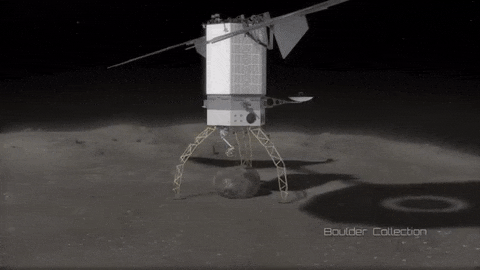
This mission to visit a large near-Earth asteroid is part of our plan to advance the new technologies and spaceflight experience needed for a human mission to the Martian system in the 2030s.
How exactly will it work?
The robotic spacecraft, powered by the most advanced solar electric propulsion system, will travel for about 18 months to the target asteroid.

After the spacecraft arrives and the multi-ton boulder is collected from the surface, the spacecraft will hover near the asteroid to create a gravitational attraction that will slightly change the asteroid’s trajectory.

After the enhanced gravity tractor demonstration is compete, the robotic vehicle will deliver the boulder into a stable orbit near the moon. During the transit, the boulder will be further imaged and studied by the spacecraft.

Astronauts aboard the Orion spacecraft will launch on the Space Launch System rocket to explore the returned boulder.

Orion will dock with the robotic vehicle that still has the boulder in its grasp.

While docked, two crew members on spacewalks will explore the boulder and collect samples to bring back to Earth for further study.

The astronauts and collected samples will return to Earth in the Orion spacecraft.
How will ARM help us send humans to Mars in the 2030s?

This mission will demonstrate future Mars-level exploration missions closer to home and will fly a mission with technologies and real life operational constraints that we’ll encounter on the way to the Red Planet. A few of the capabilities it will help us test include:
Solar Electric Propulsion – Using advanced Solar Electric Propulsion (SEP) technologies is an important part of future missions to send larger payloads into deep space and to the Mars system. Unlike chemical propulsion, which uses combustion and a nozzle to generate thrust, SEP uses electricity from solar arrays to create electromagnetic fields to accelerate and expel charged atoms (ions) to create a very low thrust with a very efficient use of propellant.
Trajectory and Navigation – When we move the massive asteroid boulder using low-thrust propulsion and leveraging the gravity fields of Earth and the moon, we’ll validate critical technologies for the future Mars missions.
Advances in Spacesuits – Spacesuits designed to operate in deep space and for the Mars surface will require upgrades to the portable life support system (PLSS). We are working on advanced PLSS that will protect astronauts on Mars or in deep space by improving carbon dioxide removal, humidity control and oxygen regulation. We are also improving mobility by evaluating advances in gloves to improve thermal capacity and dexterity.
Sample Collection and Containment Techniques – This experience will help us prepare to return samples from Mars through the development of new techniques for safe sample collection and containment. These techniques will ensure that humans do not contaminate the samples with microbes from Earth, while protecting our planet from any potential hazards in the samples that are returned.
Rendezvous and Docking Capabilities – Future human missions to Mars will require new capabilities to rendezvous and dock spacecraft in deep space. We will advance the current system we’ve developed with the international partners aboard the International Space Station.
Moving from spaceflight a couple hundred miles off Earth to the proving ground environment (40,000 miles beyond the moon) will allow us to start accumulating experience farther than humans have ever traveled in space.
Make sure to follow us on Tumblr for your regular dose of space: http://nasa.tumblr.com
Dangling in a previously unexplored lava tunnel on the Moon...
...with a massive solar flare passing overhead...
...causing unsafe radiation levels.
All communications have been interrupted.
Status of Commander Callie Rodriguez: unknown.
In our first issue of "First Woman," we followed Callie on her trailblazing journey to the Moon. Find out what’s next for our fictional first woman in a story inspired by real NASA astronauts and our upcoming Artemis missions to land the first female astronaut and person of color on the lunar surface.
See what discoveries – and challenges – lay ahead for Callie and her fellow human and robotic explorers as they forge a path to expand humanity's understanding of the universe.
Coming soon in English and Spanish at nasa.gov/calliefirst!
Make sure to follow us on Tumblr for your regular dose of space!
How is it like to be a NASA Earth Scientist? What Subjects are you required to excel at to become one? Were you really good in your studies, when you were a young teenager?
4 people are living in an isolated habitat for 30 days. Why? Science!
This 30 day mission will help our researchers learn how isolation and close quarters affect individual and group behavior. This study at our Johnson Space Center prepares us for long duration space missions, like a trip to an asteroid or even to Mars.

The Human Research Exploration Analog (HERA) that the crew members will be living in is one compact, science-making house. But unlike in a normal house, these inhabitants won't go outside for 30 days. Their communication with the rest of planet Earth will also be very limited, and they won’t have any access to internet. So no checking social media kids!
The only people they will talk with regularly are mission control and each other.

The crew member selection process is based on a number of criteria, including the same criteria for astronaut selection.
What will they be doing?
Because this mission simulates a 715-day journey to a Near-Earth asteroid, the four crew members will complete activities similar to what would happen during an outbound transit, on location at the asteroid, and the return transit phases of a mission (just in a bit of an accelerated timeframe). This simulation means that even when communicating with mission control, there will be a delay on all communications ranging from 1 to 10 minutes each way. The crew will also perform virtual spacewalk missions once they reach their destination, where they will inspect the asteroid and collect samples from it.
A few other details:
The crew follows a timeline that is similar to one used for the ISS crew.
They work 16 hours a day, Monday through Friday. This includes time for daily planning, conferences, meals and exercises.
They will be growing and taking care of plants and brine shrimp, which they will analyze and document.
But beware! While we do all we can to avoid crises during missions, crews need to be able to respond in the event of an emergency. The HERA crew will conduct a couple of emergency scenario simulations, including one that will require them to maneuver through a debris field during the Earth-bound phase of the mission.

Throughout the mission, researchers will gather information about cohabitation, teamwork, team cohesion, mood, performance and overall well-being. The crew members will be tracked by numerous devices that each capture different types of data.

Past HERA crew members wore a sensor that recorded heart rate, distance, motion and sound intensity. When crew members were working together, the sensor would also record their proximity as well, helping investigators learn about team cohesion.
Researchers also learned about how crew members react to stress by recording and analyzing verbal interactions and by analyzing “markers” in blood and saliva samples.

In total, this mission will include 19 individual investigations across key human research elements. From psychological to physiological experiments, the crew members will help prepare us for future missions.
UPDATE:
Mission success! After a simulated mission to an asteroid, the crew “splashed down” around 10:30 p.m. EST on Wednesday, Feb. 24 and exited the habitat for the first time in 30 days.
Want a full, 360 degree look at HERA? Check out and explore the inside of the habitat.
Make sure to follow us on Tumblr for your regular dose of space: http://nasa.tumblr.com

We asked real life astronauts YOUR questions! Was your submission sent to space?
Astronauts Drew Feustel & Ricky Arnold recently recorded answers to your questions in a Video Answer Time session. We collected your questions and sent them to space to be answered by the astronauts on Friday, May 18. We recorded their answers and will post them tomorrow, May 30, here on our Tumblr.
Was your question selected to be sent to the International Space Station? Check our Tumblr tomorrow, starting at noon EDT to find out!
About the astronauts:
Andrew J. Feustel was selected by NASA in 2000. He has been assigned to Expedition 55/56, which launched in March 2018. The Lake Orion, Michigan native has a Ph.D. in the Geological Sciences, specializing in Seismology, and is a veteran of two spaceflights. Follow Feustel on Twitter and Instagram.
Richard R. Arnold II was selected as an astronaut by NASA in May 2004. The Maryland native worked in the marine sciences and as a teacher in his home state, as well as in countries such as Morocco, Saudi Arabia, and Indonesia. Follow Arnold on Twitter and Instagram.
Don’t forget check our Tumblr tomorrow at noon EDT to see if your question was answered by real-life astronauts in space.
Make sure to follow us on Tumblr for your regular dose of space: http://nasa.tumblr.com.
Solar System: Things to Know this Week
On May 22 Mars will be at opposition. That's when Mars, Earth and the sun all line up, with Earth directly in the middle. A few days later, Mars and Earth will reach the points in their orbits around the sun where they are nearest to each other. The closer Mars comes to Earth in its orbit, the larger and brighter it appears in the sky.

It's an opportunity for backyard skywatchers—and a good time to catch up on all the exploration now underway at the Red Planet. Here are a few things to know this week about Mars:
1. Red Star Rising

The best time to see Mars at its brightest is when it's highest in the sky, which is around midnight during May. Look toward the south in the constellation Scorpius (where right now you can also catch the planet Saturn). If you have a telescope, you may be able to pick out some of the features on its surface. But don't fall for Internet rumors claiming that Mars will appear as big as the full moon. Instead, it will look like a bright, reddish or orange star. Get Mars viewing tips HERE.
2. Roving Weather Reporter

Our Mars Curiosity mission has now been roving across the floor of Gale Crater for two full Martian years—that's four Earth years. This robotic geologist is a meteorologist, too, and its long journey has allowed it to observe the local weather for two full seasonal cycles. During that time, the rover's instruments have recorded temperatures ranging from 60.5 degrees Fahrenheit (15.9 degrees Celsius) on a summer afternoon, to minus 148 F (minus 100 C) on a winter night. They also detected an intriguing spike in methane gas—but it hasn't happened since.
3. Increasing Clouds, with a Chance of Dust Storms

The Mars Reconnaissance Orbiter keeps an eye on Martian weather, too, but on a global scale. Every week, you can see the latest weather report, including an animation showing storms and clouds across the face of Mars.
4. Walking the Ancient Shoreline

Mars explorers have studied evidence for years that the early history of the planet included times where liquid water flowed and pooled freely. But just how deep those ancient lakes were, and how long they lasted, remains a topic of debate. A new study offers a more detailed picture of the rise and fall of standing bodies of water.
5. Wish Upon a Star

It's true that Mars will be especially bright in the sky this week. But did you ever consider that Earth often shines for Mars as well? This image from the Curiosity rover shows our whole world as a single point of light. When people finally do stand on Mars, they'll be able to look at the twilight sky—and see home. Left: the Earth and the Moon in the evening sky of Mars, as seen by the Curiosity rover. Right: Mars rising over Salt Lake City. Mars credit: NASA/JPL-Caltech/MSSS/TAMU. Earth credit: Bill Dunford.
Want to learn more? Read our full list of the 10 things to know this week about the solar system HERE.
Make sure to follow us on Tumblr for your regular dose of space: http://nasa.tumblr.com
NASA’s 60th Anniversary: Trailblazing Technology
Technology drives exploration. For 60 years, we have advanced technology to meet the rigorous needs of our missions. From GPS navigation to water filtration systems, our technologies developed for space improve your daily life on Earth. We continue to innovate and explore. Since we opened for business on Oct. 1, 1958, our history tells a story of exploration, innovation and discoveries. The next 60 years, that story continues. Learn more: https://www.nasa.gov/60
Make sure to follow us on Tumblr for your regular dose of space: http://nasa.tumblr.com.
Cygnus Cargo Craft: What’s Onboard?

New experiments are scheduled to arrive to the International Space Station with the launch of Orbital ATK’s Cygnus cargo spacecraft on Tuesday. These science payloads will study fires, meteors, regolith, adhesion and 3-D printing in microgravity.
Take a look at the experiments:
Saffire-I

What is it? What happens when you set a fire in space? The Spacecraft Fire Experiment-I (Saffire-I) will find out!
How does it work? This experiment will intentionally light a large-scale fire inside an empty Cygnus resupply vehicle after it leaves the space station and before it re-enters Earth’s atmosphere.
Why is it important? The Saffire-I investigation provides a new way to study a realistic fire on an exploration vehicle, which has not been possible in the past because the risks for performing studies on manned spacecraft are too high. Instruments on the returning Cygnus will measure flame growth, oxygen use and more.
Meteor

What is it? A less heated investigation, Meteor Composition Determination (Meteor) will enable the first space-based observations of meteors entering Earth’s atmosphere from space. Meteors are somewhat rare and are difficult to monitor from the ground because of Earth’s atmosphere.
How does it work? This investigation uses high-resolution video and image analysis of the atmosphere to acquire the physical and chemical properties of the meteoroid dust, such as size, density and chemical composition.
Why is it important? Studying the elemental composition of meteors adds to our understanding of how the planets developed, and continuous measurement of meteor interactions with Earth’s atmosphere could spot previously unforeseen meteors.
Strata-1

What is it? A more “grounded” investigation will study the properties and behavior of regolith, the impact-shatterd “soil” found on asteroids, comets, the moon and other airless worlds.
How does it work? The Strata-1 experimental facility exposes a series of regolith simulants, including pulverized meteorite material, glass beads, and regolith simulants composed of terrestrial materials and stored in multiple transparent tubes, to prolonged microgravity on the space station. Scientists will monitor changes in regolith layers and layering, size sorting and particle migration via video images and close examination after return of the samples to Earth.
Why is it important? The Strata-1 investigation could give us new answers about how regolith behaves and moves in microgravity, how easy or difficult it is to anchor a spacecraft in regolith, how it interacts with spacecraft and spacesuit materials and other important properties.
Gecko Gripper

What is it? From grounded to gripping, another investigation launching takes inspiration from small lizards. Geckos have specialized hairs on their feed called setae that let them stick to vertical surfaces without falling, and their stickiness doesn’t wear off after repeated use. The Gecko Gripper investigation tests a gecko-adhesive gripping device that can stick on command in the harsh environment of space.
How does it work? The gripping device is a material with synthetic hairs much like setae that are much thinner than a human hair. When a force is applied to make the tiny hairs bend, the positively charged part of a molecule within a slight electrical field attracts the negatively charged part of its neighbor resulting in “stickiness.” Once adhered, the gripper can bear loads up to 20 pounds. The gripper can remain in place indefinitely and can also be easily removed and reused.
Why is it important? Gecko Grippers have many applications on current and future space missions, including acting as mounting devices for payloads, instruction manuals and many other small items within the space station. In addition, this technology enables a new type of robotic inspection system that could prove vital for spacecraft safety and repair.
Additive Manufacturing Facility

What is it? From adhesion to additive, the new Additive Manufacturing Facility (AMF) will also launch on the flight. Additive manufacturing (3D printing) is the process of building a part layer-by-layer, with an efficient use of the material.
How does it work? The AMF uses this technology to enable the production of components on the space station for both NASA and commercial objectives.
Why is it important? Parts, entire experiments and tools can be created on demand with this technology. The ability to manufacture on the orbiting laboratory enables on-demand repair and production capability, as well as essential research for manufacturing on long-term missions.
These sticky, stony and sizzling investigations are just a sampling of the wide range of science conducted on the orbiting laboratory that benefits future spaceflight and provides Earth-based benefits as well.
Watch the Launch!
You can watch the launch of Orbital ATK’s Cygnus spacecraft online. Stream live coverage starting at 10 p.m. EDT on March 22. Launch is scheduled for 11:05 p.m., which is the start of a 30-minute launch window.
Watch online: nasa.gov/nasatv
Make sure to follow us on Tumblr for your regular dose of space: http://nasa.tumblr.com
Want to Become an Astronaut? You Might Be More Qualified Than You Think
Have you ever wondered if you have what it takes to become a NASA Astronaut? We’re accepting applications starting March 2, and we’re encouraging all eligible Americans to apply by March 31!
It’s an incredible time in human spaceflight to be an astronaut. With Artemis, our sights are set on the Moon – to stay – by utilizing sustainable lunar missions, and you could be one of the humans on the surface! During their careers, this next class of astronauts may also fly on any of four different U.S. spacecraft: the International Space Station, Boeing’s CST-100 Starliner, SpaceX’s Crew Dragon and our Orion deep-space exploration vehicle; They will be at the cutting edge of a new era in human exploration.
So, still interesting in joining our ranks as an Artemis generation astronaut? Here are a few things to note.
Myths about becoming an astronaut:

MYTH: All astronauts have piloting experience.
FACT: You don’t need to be a pilot to be an astronaut. Flying experience is not a requirement, but could be beneficial to have.

MYTH: All astronauts have perfect vision.
FACT: It’s okay if you don’t have 20/20 vision. As of September 2007, corrective surgical procedures of the eye (PRK and LASIK), are now allowed, providing at least 1 year has passed since the date of the procedure with no permanent adverse after effects.

MYTH: All astronauts have advanced degrees like, a PhD.
FACT: While a Master’s degree from an accredited university is necessary, the requirement can also be met with the completion (or current enrollment that will result in completion by June 2021) of a nationally recognized test pilot school program.

MYTH: Astronauts are required to have military experience in order to be selected.
FACT: Military experience is not required to become an astronaut.

MYTH: You have to be a certain age in order to be an astronaut.
FACT: There are no age restrictions. Astronaut candidates selected in the past have ranged between the ages of 26 and 46, with the average age being 34.
Okay, but what are the requirements?

The basic requirements to apply include United States citizenship and a master’s degree in a STEM field, including engineering, biological science, physical science, computer science, or mathematics, from an accredited institution. The requirement for the master’s degree can also be met by:
Two years (36 semester hours or 54 quarter hours) of work toward a Ph.D. program in a related science, technology, engineering or math field;
A completed doctor of medicine or doctor of osteopathic medicine degree;
Completion (or current enrollment that will result in completion by June 2021) of a nationally recognized test pilot school program.
Candidates also must have at least two years of related, progressively responsible professional experience, or at least 1,000 hours of pilot-in-command time in jet aircraft. Astronaut candidates must pass the NASA long-duration spaceflight physical.

Applications for our next Artemis astronaut class open on March 2! Shoot for the stars and visit: https://www.nasa.gov/astronauts
Make sure to follow us on Tumblr for your regular dose of space: http://nasa.tumblr.com
Space Gardening 101
You can’t escape eating (or gardening!) your vegetables, even if you’re in space. On Aug. 10, astronauts on the International Space Station sampled their first space grown salad. This freshly harvest red romaine lettuce was grown in the “Veggie” plant growth chamber that is designed to make gardens flourish in weightlessness.
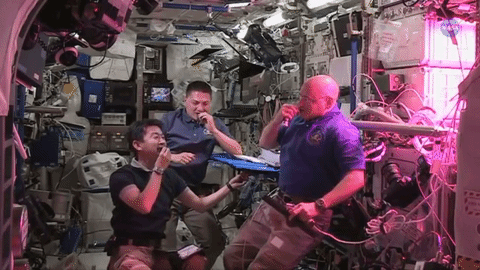
In a weightless environment, there is no up and down, so roots grow in all directions. Water and soil, the materials used to anchor these plants and allow for root growth tend to float away.
How Do We Grow Plants in Space?
1. Plant Pillows
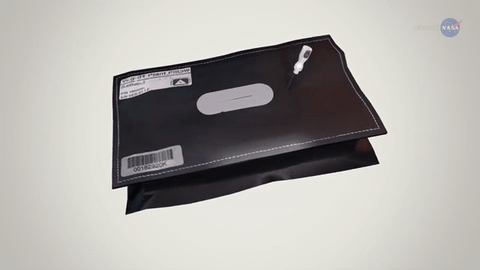
The Veggie chamber helps solve the problems of a weightless environment by using ‘plant pillows’, sounds comfy right? These pillows are bags filled with material for growing plants in space.
2. Wicks

Wicks are implanted into the bags and are used to draw water from inside the pillow to the plant.
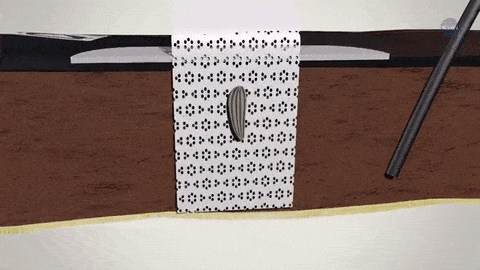
These wicks also provide a place to glue the seeds. It’s important to orient the seeds so roots will grow ‘down’, and shoots that emerge will push out of the bag.
3. LED Lights
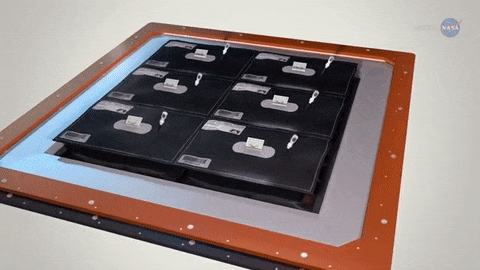
LED lights are used for photosynthesis and give the shoots a sense of direction so they keep growing upward. The walls of the Veggie chamber can expand to make room for the plant as it grows.
The purple/pinkish hue surrounding the plants in Veggie is the result of a combination of the red and blue lights, which is what the plants need to grow. Green LEDS were added so the plants look like edible food rather than weird purple plants.
Why are we growing plants in space?
When astronauts travel on deep space missions, like Mars, they will need to be self-sufficient for long periods of time. Having the ability to grow their own food is a big step in that direction. There is also a desire to grow flowering vegetables in space, which is why we are currently tending to zinnia flowers on orbit. Growing these flowering plants will help us understand longer duration growing plants that have to flower in space, such as tomatoes.
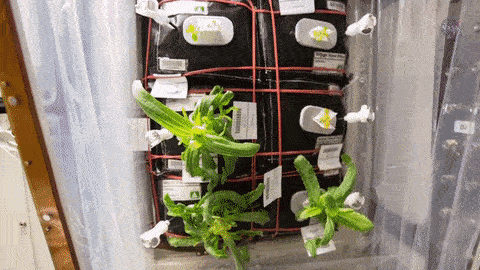
What’s Next? The next SpaceX delivery will include seeds for a small cabbage and additional red romaine lettuce. Upcoming experiments will use various ratios of red and blue lights and different fertilizers in attempts to improve crop yield, nutrition and flavor. The findings from these experiments can be utilized both on Earth and in space.
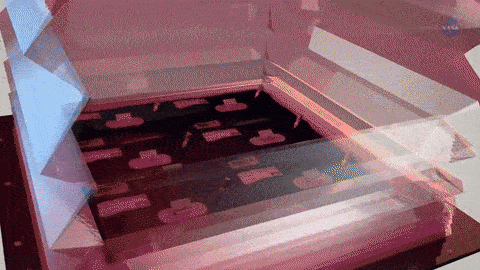
In addition to the nutrition benefits of growing vegetables in space, the psychological benefits are also significant. Having living plants can help with stress and increase the crews’ enjoyment. It provides the sights, smells and tastes of Earth.
To learn more about gardening in space, watch ScienceCast HERE.
Make sure to follow us on Tumblr for your regular dose of space: http://nasa.tumblr.com
-
 mistflyer1102 reblogged this · 1 week ago
mistflyer1102 reblogged this · 1 week ago -
 beloved-detective liked this · 1 month ago
beloved-detective liked this · 1 month ago -
 andy202405 liked this · 1 month ago
andy202405 liked this · 1 month ago -
 luhuhul liked this · 1 month ago
luhuhul liked this · 1 month ago -
 peppermintschnapps reblogged this · 2 months ago
peppermintschnapps reblogged this · 2 months ago -
 dustybanjo liked this · 3 months ago
dustybanjo liked this · 3 months ago -
 skarletta-arts liked this · 3 months ago
skarletta-arts liked this · 3 months ago -
 gay4carver liked this · 3 months ago
gay4carver liked this · 3 months ago -
 apollosgiftofprophecy reblogged this · 3 months ago
apollosgiftofprophecy reblogged this · 3 months ago -
 b3rryb0yspr0ut liked this · 3 months ago
b3rryb0yspr0ut liked this · 3 months ago -
 starrynightchaosencok liked this · 4 months ago
starrynightchaosencok liked this · 4 months ago -
 sunshinefullsun reblogged this · 4 months ago
sunshinefullsun reblogged this · 4 months ago -
 dreamy-skull liked this · 4 months ago
dreamy-skull liked this · 4 months ago -
 shilo-sumac reblogged this · 6 months ago
shilo-sumac reblogged this · 6 months ago -
 grandma-course liked this · 6 months ago
grandma-course liked this · 6 months ago -
 dreamerwriternstargazer reblogged this · 6 months ago
dreamerwriternstargazer reblogged this · 6 months ago -
 dreamerwriternstargazer liked this · 6 months ago
dreamerwriternstargazer liked this · 6 months ago -
 praetyger reblogged this · 6 months ago
praetyger reblogged this · 6 months ago -
 k-ru-h reblogged this · 6 months ago
k-ru-h reblogged this · 6 months ago -
 k-ru-h liked this · 6 months ago
k-ru-h liked this · 6 months ago -
 unbestedmartell liked this · 7 months ago
unbestedmartell liked this · 7 months ago -
 absolutesciencefiction reblogged this · 7 months ago
absolutesciencefiction reblogged this · 7 months ago -
 androidsghost liked this · 7 months ago
androidsghost liked this · 7 months ago -
 haz77zard reblogged this · 7 months ago
haz77zard reblogged this · 7 months ago -
 haz77zard liked this · 7 months ago
haz77zard liked this · 7 months ago -
 timer1689 liked this · 9 months ago
timer1689 liked this · 9 months ago -
 my-beautiful-portal liked this · 9 months ago
my-beautiful-portal liked this · 9 months ago -
 impishevil liked this · 9 months ago
impishevil liked this · 9 months ago -
 rosakai reblogged this · 10 months ago
rosakai reblogged this · 10 months ago -
 accidentallyoccidental reblogged this · 10 months ago
accidentallyoccidental reblogged this · 10 months ago -
 me-choy-me-noy liked this · 10 months ago
me-choy-me-noy liked this · 10 months ago -
 leafstem reblogged this · 11 months ago
leafstem reblogged this · 11 months ago -
 leafstem liked this · 11 months ago
leafstem liked this · 11 months ago -
 katastrophic-n3vulaa reblogged this · 11 months ago
katastrophic-n3vulaa reblogged this · 11 months ago -
 katastrophic-n3vulaa reblogged this · 11 months ago
katastrophic-n3vulaa reblogged this · 11 months ago -
 thegirlsinthecity liked this · 11 months ago
thegirlsinthecity liked this · 11 months ago -
 esuemmanuel reblogged this · 11 months ago
esuemmanuel reblogged this · 11 months ago -
 bubblgobbo reblogged this · 11 months ago
bubblgobbo reblogged this · 11 months ago -
 deleted-heavens-gate liked this · 11 months ago
deleted-heavens-gate liked this · 11 months ago -
 desertowlsclover reblogged this · 11 months ago
desertowlsclover reblogged this · 11 months ago -
 onparacosm reblogged this · 11 months ago
onparacosm reblogged this · 11 months ago -
 onparacosm liked this · 11 months ago
onparacosm liked this · 11 months ago -
 alternate-silversurfer-blog reblogged this · 1 year ago
alternate-silversurfer-blog reblogged this · 1 year ago -
 alternate-silversurfer-blog liked this · 1 year ago
alternate-silversurfer-blog liked this · 1 year ago -
 sophieschiffer liked this · 1 year ago
sophieschiffer liked this · 1 year ago
Explore the universe and discover our home planet with the official NASA Tumblr account
1K posts